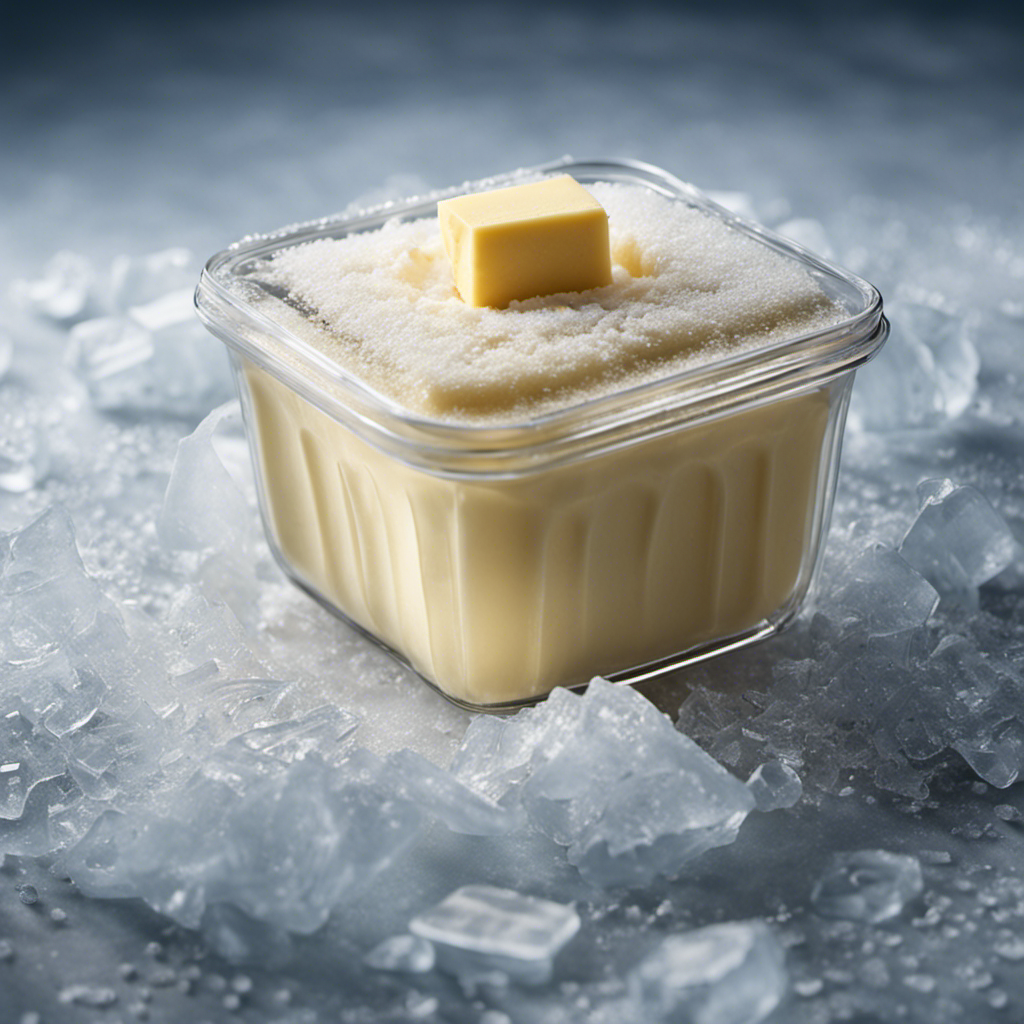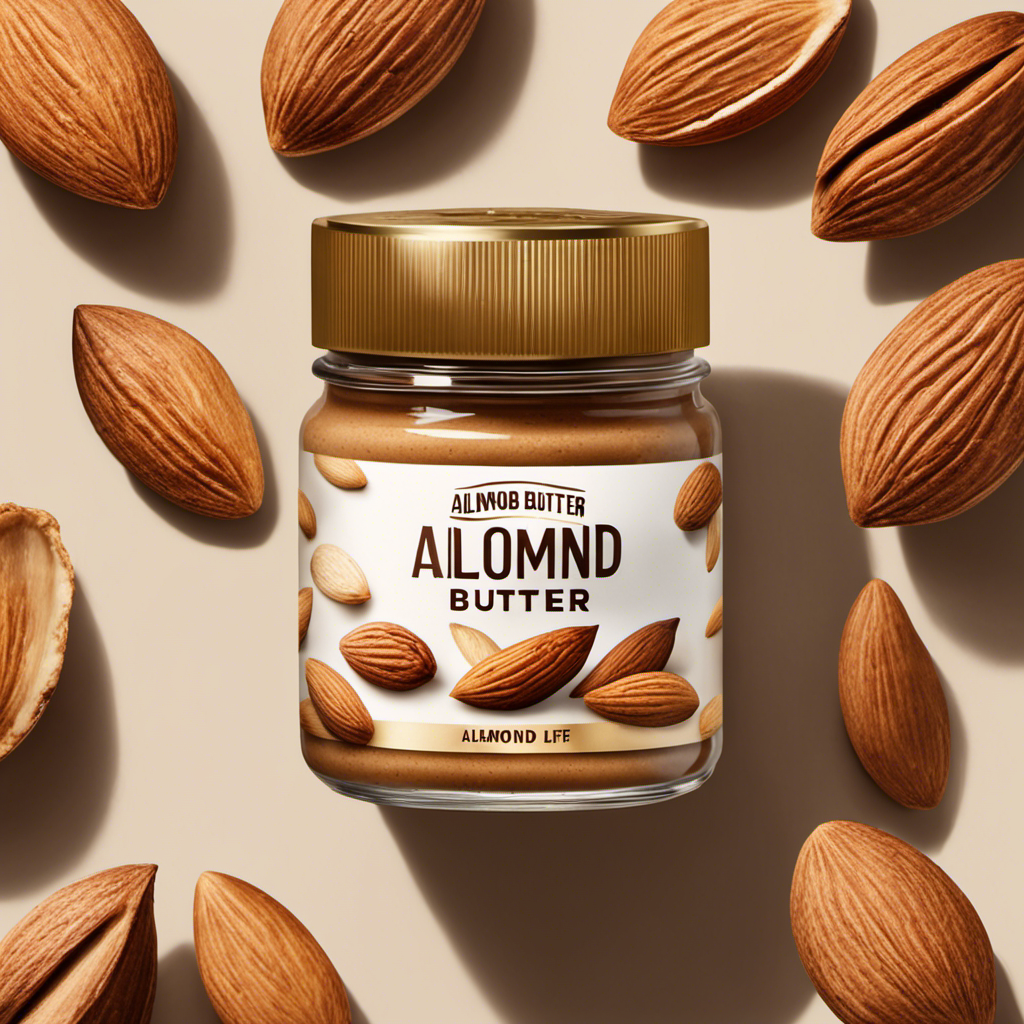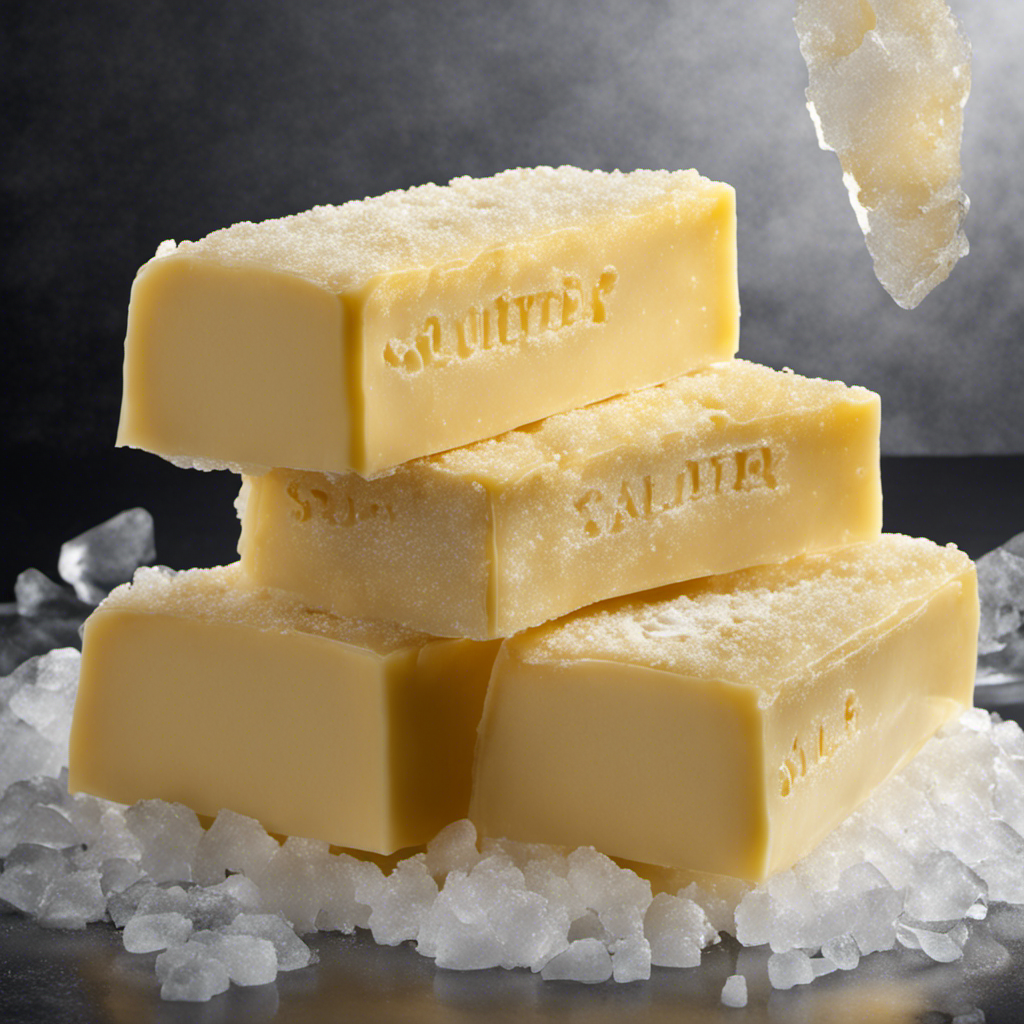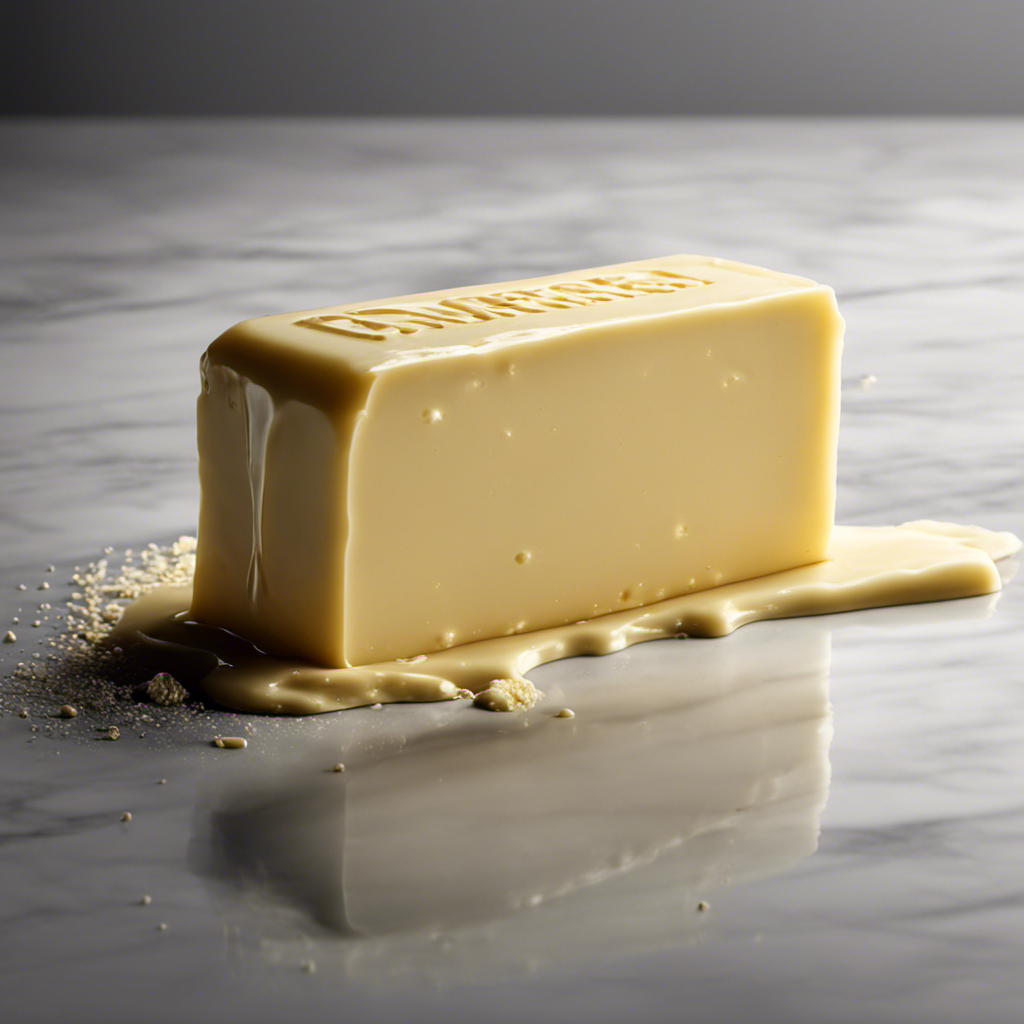As a fan of almond butter, I frequently wonder, “How long does almond butter last once opened?”
Well, the answer is not as straightforward as we might hope.
In this article, we will delve into the factors that affect the freshness of almond butter, explore the best practices for storing and preserving its quality, and decipher those mysterious expiration dates on the jar.
So grab a spoon and get ready to learn everything you need to know about extending the lifespan of your favorite nutty spread.
Key Takeaways
- Once opened, almond butter has a shelf life of about six months.
- Signs of spoilage include mold growth, rancid odor, grainy or clumpy consistency, and dryness or stickiness.
- Expired almond butter can still be used in recipes after conducting a smell and taste test.
- Proper storage techniques, such as tightly sealing the container and keeping it in a cool, dark place, are essential for maintaining almond butter freshness.
Shelf Life of Almond Butter After Opening
Almond butter typically lasts for several months after opening. However, the shelf life can vary depending on several factors affecting spoilage.
One of the most important factors is how the almond butter is stored. Common storage mistakes can significantly reduce its shelf life. For example, exposure to heat and sunlight can cause the oil in almond butter to go rancid faster. It is essential to store almond butter in a cool, dry place, away from direct sunlight.
Another factor to consider is contamination. Using dirty utensils or double-dipping can introduce bacteria into the almond butter, leading to spoilage. To maximize the shelf life of almond butter, it is recommended to always use clean utensils and avoid cross-contamination.
Factors Affecting the Freshness of Almond Butter
To maintain the freshness of your almond butter, it’s important to consider various factors such as storage temperature and exposure to air.
Temperature plays a crucial role in determining the taste and texture of almond butter. It is recommended to store almond butter in a cool, dry place, away from direct sunlight and heat sources.
Exposure to air can also affect the taste of almond butter, causing it to become rancid more quickly. To prevent this, make sure to tightly seal the container after each use.
Additionally, incorporating almond butter into recipes can enhance both flavor and nutrition. You can use almond butter in smoothies, baked goods, and even savory dishes like stir-fries or salad dressings.
Experimenting with almond butter in different recipes can add variety and health benefits to your meals.
Storing Almond Butter for Maximum Longevity
When it comes to storing almond butter, it’s important to follow proper storage techniques to ensure its maximum freshness and longevity.
This includes keeping it in a cool, dry place away from direct sunlight and heat sources.
Additionally, it’s crucial to adhere to the shelf life guidelines provided by the manufacturer and be aware of the signs of spoilage, such as changes in texture, color, or smell.
Proper Storage Techniques
Make sure you store your almond butter in an airtight container to keep it fresh for as long as possible. Proper storage techniques are crucial in maintaining the quality and extending the shelf life of almond butter.
Here are some tips to help you store your almond butter properly:
-
Keep it in a cool, dark place: Almond butter is sensitive to light and heat, so storing it in a cool, dark cupboard or pantry will help preserve its freshness.
-
Avoid moisture: Moisture can cause almond butter to spoil quickly, so make sure the container is tightly sealed and keep it away from water or humid environments.
-
Refrigeration: While not necessary, refrigerating almond butter can help extend its shelf life even further. Just make sure to let it come to room temperature before using.
Almond butter is not only delicious but also offers numerous health benefits. It is a great source of healthy fats, protein, and fiber. Incorporating almond butter into your diet can promote heart health, aid in weight management, and provide a natural energy boost.
Plus, it can be used in a variety of recipes, from smoothies and oatmeal to baked goods and homemade granola bars. So, make the most of this nutritious spread and enjoy its many benefits.
Shelf Life Guidelines
Remember, storing your almond butter in a cool and dark place will help maintain its quality and freshness.
When it comes to the shelf life of almond butter, there are a few indicators to keep in mind. Typically, an unopened jar of almond butter can last up to two years. However, once opened, the shelf life decreases to about six months.
It’s important to check for any signs of spoilage, such as a rancid smell, mold, or an off taste. If your almond butter has expired, there are still ways to make use of it. You can use it as an ingredient in baked goods or smoothies, or even as a topping for oatmeal or pancakes. Just make sure to do a quick smell and taste test before using it, and if it doesn’t seem right, it’s best to discard it.
Signs of Spoilage
After understanding the shelf life guidelines for almond butter, it’s important to be aware of the signs of spoilage to ensure its quality. Here are some key points to consider:
-
Appearance:
-
Mold growth or discoloration
-
Separation of oil and solids
-
Smell:
-
Rancid or off-putting odor
-
Texture:
-
Grainy or clumpy consistency
-
Dryness or stickiness
By paying attention to these indicators, you can easily determine if your almond butter has gone bad.
To extend the shelf life and preserve the quality of your almond butter, make sure to follow these tips:
- Store it in a cool, dry place
- Keep it tightly sealed
- Avoid exposing it to direct sunlight or heat
Understanding the signs of spoiled almond butter is crucial in ensuring that you consume a safe and enjoyable product.
Signs of Spoiled Almond Butter
If you see any mold, an off smell, or a change in texture, it’s time to throw out your almond butter. These are clear signs that your almond butter has gone bad.
Mold growth indicates that the product has been contaminated and should not be consumed. An off smell, such as a rancid or sour odor, suggests that the almond butter has spoiled and is no longer safe to eat.
Additionally, if you notice a change in texture, such as clumps or separation of oil, it is another indication of spoilage.
To prevent almond butter from spoiling, it is important to store it properly. Keep it tightly sealed in its original container or transfer it to an airtight jar. Store it in a cool, dry place away from direct sunlight.
How to Extend the Lifespan of Almond Butter
When it comes to extending the lifespan of almond butter, there are a few key points to consider. Proper storage techniques play a crucial role in maintaining its freshness and preventing spoilage.
Shelf life tips, such as keeping it in a cool and dry place, can also help to preserve its quality. Additionally, there are various methods for preserving freshness, such as refrigerating or freezing almond butter.
Proper Storage Techniques
To keep your almond butter fresh, it’s important to store it properly. Here are some tips for preserving its shelf life:
-
Choose the right storage container: Opt for airtight containers made of glass or BPA-free plastic. This helps prevent exposure to air and moisture, which can cause the almond butter to spoil faster.
-
Keep it in a cool, dark place: Almond butter is sensitive to heat and light, so store it in a pantry or cupboard away from direct sunlight or heat sources.
-
Avoid cross-contamination: To prevent the growth of bacteria, use a clean spoon or knife every time you scoop out almond butter. Avoid touching it directly with your fingers.
Shelf Life Tips
Storing almond butter in a cool, dark place helps extend its shelf life. Proper storage techniques are essential in maintaining the freshness and quality of almond butter. One important factor to consider is shelf stability, which refers to how long a product can retain its quality before it starts to degrade. Almond butter typically has a shelf life of around 6-12 months when stored properly. To ensure maximum freshness, it is important to use proper storage containers. Airtight containers, such as glass jars or plastic containers with tight-fitting lids, are ideal for preserving the flavor and texture of almond butter. These containers help protect it from exposure to air, moisture, and light, which can accelerate the degradation process. By following these tips, you can enjoy your almond butter for longer periods of time.
| Shelf Stability | Storage Containers |
|---|---|
| 6-12 months | Airtight containers |
| (glass jars, | |
| plastic containers) |
Preserving Freshness Methods
Preserving the freshness of almond butter can be achieved by using airtight containers. By doing so, you can prolong the lifespan of this delicious spread and ensure its quality for a longer period of time.
Here are some techniques for preserving the freshness of almond butter:
- Store almond butter in airtight containers to prevent exposure to air, which can cause oxidation and spoilage.
- Keep almond butter in a cool, dark place to minimize heat and light exposure, which can accelerate rancidity.
- Avoid introducing moisture into the container, as it can promote the growth of bacteria and mold.
Proper Handling and Storage of Opened Almond Butter
After you’ve opened a jar of almond butter, it’s important to handle and store it properly to maintain its freshness and quality. One key factor in preserving almond butter is the storage temperature.
It is recommended to store almond butter in a cool, dry place, away from direct sunlight and heat sources. The ideal storage temperature for almond butter is around 55 to 60 degrees Fahrenheit.
This temperature range helps prevent rancidity, which is the process of the oil in almond butter becoming spoiled and giving off a stale, unpleasant taste. By storing almond butter at the correct temperature, you can extend its shelf life and ensure it remains fresh and flavorful for longer periods.
Best Practices for Preserving Almond Butter Quality
To maintain the quality of your opened almond butter, it’s crucial to handle it properly and store it at the recommended temperature. Here are some best practices for preserving the taste of your almond butter and preventing it from turning rancid:
-
Keep it sealed: After each use, make sure to tightly seal the jar to prevent air from entering and causing oxidation.
-
Store it in the refrigerator: Almond butter should be stored in the refrigerator to maintain its freshness and prevent the natural oils from going rancid.
-
Avoid contamination: Always use a clean utensil to scoop out almond butter and avoid introducing any moisture or crumbs into the jar.
By following these guidelines, you can ensure that your almond butter stays delicious and free from rancidity for as long as possible.
Enjoy the rich and creamy taste of your almond butter without any worries!
Understanding Expiration Dates on Almond Butter Jars
Now that we understand the best practices for preserving almond butter quality, let’s delve into understanding the expiration dates on almond butter jars. By familiarizing ourselves with these dates, we can ensure that we consume our almond butter at its freshest and safest state.
When examining the expiration date on an almond butter jar, it’s important to note that it refers to the product’s shelf life when unopened. Once opened, almond butter can typically last for up to three months if stored properly. However, it’s crucial to consider the ingredients used in the almond butter, as they can affect its longevity. Natural almond butter, made solely from almonds, may have a shorter shelf life compared to those with added ingredients like oils or sweeteners.
Aside from understanding expiration dates, it’s essential to highlight the health benefits of almond butter. This nutritious spread is packed with vitamins, minerals, healthy fats, and protein. It can aid in weight management, promote heart health, boost energy levels, and support brain function.
Frequently Asked Questions
Can I Freeze Almond Butter to Extend Its Shelf Life?
Yes, you can freeze almond butter to extend its shelf life. Freezing helps preserve the freshness and quality of the butter. Once thawed, it can be used in various almond butter recipes.
How Can I Tell if Almond Butter Has Gone Bad?
There are ways to preserve almond butter and signs of spoilage to look out for. It’s important to keep an eye on the texture, smell, and taste. Don’t ignore any mold or rancid odors.
Is It Safe to Eat Almond Butter Past Its Expiration Date?
I can still enjoy almond butter past its expiration date, as long as it has been stored properly. Its rich taste and creamy texture make it a healthy and delicious source of nutrition.
Can I Store Almond Butter in the Pantry Instead of the Refrigerator?
I store almond butter in the pantry, but it’s important to note that it can go rancid if not consumed within a reasonable timeframe. While refrigeration is not necessary, it can extend its shelf life.
What Are Some Creative Ways to Use Leftover Almond Butter Before It Goes Bad?
Cooking with leftover almond butter is a creative endeavor. I enjoy making almond butter smoothies or incorporating it into creative recipes like almond butter cookies. The possibilities are endless before it spoils.
Conclusion
In conclusion, almond butter can last for about 6-12 months after opening, depending on various factors such as storage conditions and quality of the product.
It is important to properly handle and store almond butter to extend its lifespan. By keeping it in a cool, dry place and using clean utensils, you can preserve its freshness.
Remember, the expiration date on the jar is a helpful guideline, but the quality of the almond butter is the ultimate indicator.
As the saying goes, "A spoonful of well-preserved almond butter is a taste of smooth, nutty heaven."










